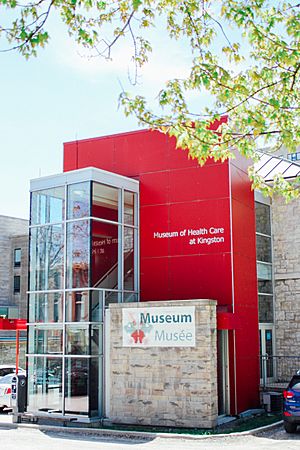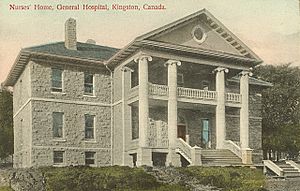Museum of Health Care facts for kids

Museum of Health Care at Kingston main entrance.
|
|
| Established | 1904 (as the Ann Baillie nursing student residence) 1995 (as the Museum of Health Care) |
|---|---|
| Location | 32 George Street, Kingston, Ontario, Canada |
| Collection size | 35,000+ artefacts |
| Designated: | 1997 |
The Museum of Health Care is a special place in Kingston, Ontario, Canada. It's located in a beautiful old building called the Ann Baillie Building. This museum tells the story of health and medicine from the 1700s all the way to today. You can explore how people stayed healthy, treated illnesses, and how doctors and nurses learned their skills over time. The museum has a huge collection of items and information you can even search online!
Contents
The Ann Baillie Building: A Historic Home
The Ann Baillie Building is a very old and important building. It was built in 1904 in a fancy style called Beaux-Arts. This style uses lots of limestone and looks grand. The building is a National Historic Site of Canada because it played a big part in the history of nursing education in Canada.
A Home for Nurses
Long ago, this building was a dormitory, which is like a residence hall. It was designed for 26 nursing students who were training at the Kingston General Hospital's School of Nursing. Before this building, nursing students lived inside the hospital. This was not ideal because it was crowded and they could get sick from patients.
The nurses' association worked hard to raise money for this new building. It gave the students a proper home. The first nurses graduated from Kingston General Hospital in 1888. Their training became a three-year program in 1905.
Changes Over Time
The School of Nursing closed in 1974. This happened because the Government of Ontario decided that nurses should be trained at colleges and universities instead. So, the Ann Baillie Building was no longer needed as a student residence.
The building was recognized as important by the City of Kingston in 1994. Then, in 1997, it was declared a national historic site. This means it's a special place that helps us remember Canada's past.
The Ann Baillie Building was one of the first homes built just for nurses in Canada. It shows how nursing became a respected profession. Nurses trained here, caring for patients in the hospital. The building was later named after Ann Baillie, a nurse who led the school for many years. Having their own place helped nurses become an essential part of health care.
Today, the Ann Baillie Building is home to the Museum of Health Care. It also houses other groups that focus on healthcare history.
Museum of Health Care: Exploring Medical History
In 1995, the Museum of Health Care moved into the Ann Baillie Building. It's the only museum in Canada that focuses entirely on the history of health and healthcare.
The museum has one of the largest collections of medical items in Canada. It holds over 35,000 objects! These include everything from old surgical tools to lab instruments. They show how people have tried to stay healthy and deal with sickness, pain, and suffering. The collection covers history from the late 1700s to today.
The museum wants to help visitors understand what life was like for people in the past. It also helps us think about health issues we face today. The museum offers exhibits, programs, and special events for everyone. This includes students, historians, and anyone curious about health.
How the Museum Started
The idea for the museum began in 1988 with a person named James Low. The museum officially started collecting items in 1991. It gathered medical and health objects from all over Canada. In 1995, it found its permanent home in the Ann Baillie Building.
The Museum of Health Care is a non-profit organization. This means it's run for public benefit, not to make money. It has been guided by a board of directors since 1996. Dr. James Low, who helped start the museum, was even given a special award, the Order of Canada, in 2014.
The museum's main goal is to save and share the history of medicine. It wants to help everyone understand how health and healthcare have changed in Canada. The museum collects, protects, studies, and displays items that tell these stories. It's also a great place for scholars to do research on healthcare history.
You can find museum exhibits inside the Ann Baillie Building. There are also "Outreach Galleries" in other healthcare centers around Kingston.
Amazing Collections
The museum has a huge collection of items and old documents. There are about 40,000 items in total! They date from the 1700s to the present day.
The collections include many different types of objects. You'll see medical, surgical, and lab tools. There are also special items that celebrate medical achievements and things used for patient care. Some big collections focus on topics like anesthesiology (making you sleep for surgery), renal dialysis (cleaning blood), orthopaedics (bone care), cardiology (heart care), patent medicines (old-time remedies), nursing, and X-ray technology.
Here are some cool things you can find:
- A heart and lung machine from around 1958. It helped doctors do complex surgeries.
- The "Kingmed" dialysis machine, made in Kingston in 1967. It's the only one left!
- A large collection of cardiac pacemakers from the 1950s to the 1990s. These devices help hearts beat regularly.
- Different types of prostheses (artificial body parts) like hips, elbows, knees, and legs from 1920 to 1975.
- An iron lung built in Toronto in 1937 during a polio outbreak. It helped people breathe. This is believed to be the last one in Canada.
- A rare Waite & Bartlett electrostatic generator from about 1910. It was used for early electrotherapy (using electricity for treatment) and X-ray imaging.
- A special collection of medical moulages. These are wax models of body parts used for teaching doctors in the 1940s.
- A Microscope once used by a famous scientist, Dr. James B. Collip.
- Over 750 Canadian nursing uniforms, photos, and other items from the 1880s to 2000.
- More than 2700 old drug containers and pharmacy items from the 1700s to the late 1900s.
- A dental history collection with old dental chairs, tools, and even a plaster cast of former prime minister John Diefenbaker’s teeth!
- About 4000 medical items from a former medical academy in Toronto, including:
- An army surgeon’s instrument case from 1812. It belonged to Dr. Henry Grasett, a chief surgeon during the War of 1812.
- A Mayer & Meltzer carbolic steam sprayer from around 1870. This was a new technology developed by Dr. Joseph Lister to make operating rooms cleaner and safer.
- An 18th-century washbasin used for keeping things clean during childbirth. This shows how doctors started to understand the importance of hygiene.
The museum has exhibits both inside its building and in other locations. These exhibits show how medicine and health care have grown. You can also take a walking tour of the Kingston General Hospital National Historic Site of Canada. In 2011, an online tour called "From the Collection" was added, showing 30 special items.
Visiting and Learning
The Museum of Health Care works with other museum groups like the CMA. It has also hosted fun events for kids, like a "Teddy Bear Hospital" in 2012. At this event, kids could bring their teddy bears for a check-up!
You can find the latest information about guided tours and educational programs on the museum's website.
See also


